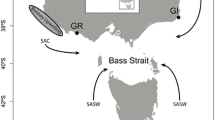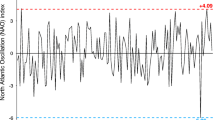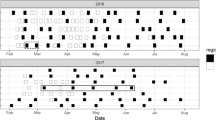Abstract
Many breeding seabird species are central-place foragers and constrained to find productive prey patches within their foraging ranges. We assessed how different populations of a pelagic seabird species, the Cory’s shearwater Calonectris diomedea, breeding in oceanic and neritic conditions, cope with these constraints in the North Atlantic, during both incubation and chick-rearing periods. We analysed 237 foraging trips to study the movements and oceanographic characteristics of foraging habitats of seven different populations of Cory’s shearwaters. Generally, oceanic populations exhibited higher foraging effort, by travelling more time and to more distant areas, and larger home ranges and feeding areas, than the neritic population (i.e. breeding on an island within the Portuguese continental platform). On their short trips (i.e. ≤4 days), birds from the different populations fed mostly in shallower waters around the colony. During long trips (i.e. ≥5 days), feeding areas of both oceanic and neritic populations were characterized by high concentration values of chlorophyll-a, low sea-surface temperature and shallower habitats, with oceanic populations of the Azores exploiting areas north of the islands over known seamounts and frontal regions. Birds from other oceanic population (Selvagens) also exploited the African continental shelf system on their long trips. The home ranges of the different populations overlapped widely, but there was a general spatial segregation in terms of the core feeding areas at the population level. Core feeding areas and areas of foraging overlap between different populations should be important to inform conservation management measures, such as the definition of Marine Important Bird Areas for seabirds over the North Atlantic.






Similar content being viewed by others
References
Ainley DG, Ribic CA, Ballard G, Heath S, Gaffney I, Karl BJ, Barton KJ, Wilson PR, Webb S (2004) Geographic structure of Adelie penguin populations: overlap in colony-specific foraging areas. Ecol Monogr 74:159–178
Amorim P, Figueiredo M, Machete M, Morato T, Martins A, Santos RS (2009) Spatial variability of seabird distribution associated with environmental factors: a case study of marine important bird areas in the Azores. ICES J Mar Sci 66:29–40
Ashmole NP (1971) Seabird ecology and the marine environment. In: Farner DS, King JR (eds) Avian biology, vol 1. Academic Press, London, pp 223–286
Ballance LT, Pitman RL, Fiedler PC (2006) Oceanographic influences on seabirds and cetaceans of the eastern tropical Pacific: a review. Prog in Oceanogr 69:360–390
Beisiegel BM, Mantovani W (2006) Habitat use, home range and foraging preferences of the coati Nasua nasua in a pluvial tropical Atlantic forest area. J Zool Lond 269:77–87
Botsford LW, Castilla JC, Peterson CH (1997) The management of fisheries and marine ecosystems. Science 277:509–515
Burger AE, Shaffer SA (2008) Application of tracking and data-logging technology in research and conservation of seabirds. Auk 125:253–264
Coll M, Libralato S, Tudela S, Palomera I, Pranovi F (2008) Ecosystem overfishing in the Ocean. PLoS ONE 3:e3881
Cury P, Bakun A, Crawford RJM, Jarre A, Quiñones RA, Shannon LJ, Verheye HM (2000) Small pelagics in upwelling systems: patterns of interaction and structural changes in “wasp-waist” ecosystems. ICES J Mar Sci 57:603–618
Dall’Antonia L, Dall’Antonia P, Benvenuti S, Ioale P, Massa B, Bonadonna F (1995) The homing behaviour of Cory’s shearwaters (Calonectris diomedea) studied by means of a direction recorder. J Exp Biol 198:359–362
Einoder LD (2009) A review of the use of seabirds as indicators in fisheries and ecosystem management. Fish Res 95:6–13
Faraway JJ (2006) Extending the linear model with R: generalized linear, mixed effects and nonparametric regression models. Chapman & Hall/CRC, Boca Raton
Fauchald P (2009) Spatial interaction between seabirds and prey: review and synthesis. Mar Ecol Prog Ser 391:139–151
Granadeiro JP (1991) The breeding biology of Cory’s shearwater Calonectris diomedea on Berlenga Island, Portugal. Seabird 13:30–39
Granadeiro JP (1993) Variation in measurements of Cory’s shearwater between populations and sexing by discriminant analysis. Ringing Migr 14:103–112
Gremillet D, Lewis S, Drapeau L, van Der Lingen CD, Huggett JA, Coetzee JC, Verheye HM, Daunt F, Wanless S, Ryan PG (2008) Spatial match-mismatch in the Benguela upwelling zone: should we expect chlorophyll and sea-surface temperature to predict marine predator distributions? J App Ecol 45:610–621
Grémillet D, Dell’Omo G, Ryan PG, Peters G, Ropert-Coudert Y, Weeks SJ (2004) Offshore diplomacy, or how seabirds mitigate intra-specific competition: a case study based on GPS tracking of Cape gannets from neighbouring colonies. Mar Ecol Prog Ser 268:265–279
Hamer KC, Humphreys EM, Garthe S, Hennicke J, Peters G, Gremillet D, Phillips RA, Harris MP, Wanless S (2007) Annual variation in diets, feeding locations and foraging behaviour of gannets in the North Sea: flexibility, consistency and constraint. Mar Ecol Prog Ser 338:295–305
Hamer KC, Humphreys EM, Magalhaes MC, Garthe S, Hennicke J, Peters G, Gremillet D, Skov H, Wanless S (2009) Fine-scale foraging behaviour of a medium-ranging marine predator. J Anim Ecol 78:880–889
Haury LR, Fey C, Newland C, Genin A (2000) Zooplankton distribution around four eastern North Pacific seamounts. Prog Oceanogr 45:69–105
Hooge PN, Eichenlaub B (1997) Animal movement extension to arcview. ver. 1.1. Alaska Science Center, Biological Science Office, U.S. Geological Survey, Anchorage
Hunt GL (1997) Physics, zooplankton, and the distribution of least auklets in the Bering Sea—a review. ICES J Mar Sci 54:600–607
Hunt GL, Mehlum F, Russell RW, Irons D, Decker MB, Becker PH (1999) Physical processes, prey abundance, and the foraging ecology of seabirds. Proc Int Ornithol Congr 22:2040–2056
ICES (2006) Current approached for identifying offshore seabird aggregations and delineating important bird areas (IBAs) and special protection areas (SPAs). Report of the working group on seabird ecology (WGSE). ICES CM 2006/LRC:08
Igual JM, Forero MG, Tavecchia G, Gonzalez-Solis J, Martinez-Abrain A, Hobson K, Ruiz W, Oro D (2005) Short-term effects of data-loggers on Cory’s shearwater (Calonectris diomedea). Mar Biol 146:619–624
Jouanin C, Roux F, Mougin JL, Stahl JC (2001) Prelaying exodus of Cory’s shearwaters (Calonectris diomedea borealis) on Selvagem Grande. J Ornithol 142:212–217
Kai ET, Rossi V, Sudre J, Weimerskirch H, Lopez C, Hernandez-Garcia E, Marsac F, Garcon V (2009) Top marine predators track Lagrangian coherent structures. Proc Natl Acad Sci USA 106:8245–8250
Lewis S, Sherratt TN, Hamer KC, Wanless S (2001) Evidence of intra-specific competition for food in a pelagic seabird. Nature 412:816–819
Magalhães MC, Santos RS, Hamer KC (2008) Dual-foraging of Cory’s shearwaters in the Azores: feeding locations, behavior at sea and implications for food provisioning of chicks. Mar Ecol Prog Ser 359:283–293
Mann KH, Lazier JRN (2005) Dynamics of marine ecosystems. Blackwell Publishing, Oxford
Morato T, Cheung WWL, Pitcher TJ (2006a) Vulnerability of seamounts fish to fishing: fuzzy analysis of life-history attributes. J Fish Biol 68:209–221
Morato T, Watson R, Pitcher TJ, Pauly D (2006b) Fishing down the deep. Fish Fish 7:24–34
Morato T, Varkey DA, Damask C, Machete M, Santos M, Prieto R, Santos RS, Pitcher TJ (2008a) Evidence of a seamount effect on aggregating visitors. Mar Ecol Prog Ser 357:23–32
Morato T, Machete M, Kitchingman A, Tempera F, Lai S, Menezes G, Pitcher TJ, Santos RS (2008b) Abundance and distribution of seamounts in the Azores. Mar Ecol Prog Ser 357:17–21
Mougin J-L, Jouanin C, Roux F (1988) Le calcul de la durée des periodes d’incubation chez le Puffin cendré Calonectris diomedea borealis de l’ile Selvagem Grande (30º09’N, 15º52’W). Cyanopica 4:155–165
Navarro J, González-Solís J (2009) Environmental determinants of foraging strategies in Cory’s shearwater Calonectris diomedea breeding on the Canary Islands, NE Atlantic. Mar Ecol Prog Ser 378:259–267
Navarro J, Gonzalez-Solis J, Viscor G (2007) Nutritional and feeding ecology in Cory’s shearwater Calonectris diomedea during breeding. Mar Ecol Prog Ser 351:261–271
Navarro J, Forero MG, Gonzalez-Solis J, Manuel Igual J, Becares J, Hobson KA (2009) Foraging segregation between two closely related shearwaters breeding in sympatry. Biol Let 5:545–548
Orians GH, Pearson NE (1979) On the theory of central place foraging. In: Horn DH, Mitchell RD, Stairs GR (eds) Analyses of ecological systems. Ohio State University Press, Columbus, pp 154–177
Paiva VH, Geraldes P, Ramírez I, Meirinho A, Garthe S, Ramos JA (2010a) Plasticity of a pelagic seabird species foraging along a marine productivity gradient. Mar Ecol Prog Ser 398:259–274
Paiva VH, Guilford T, Meade J, Geraldes P, Ramos JA, Garthe S (2010b) Flight dynamics of Cory’s Shearwater foraging in a coastal environment. Zoology 113:47–56
Pauly D, Christensen V, Guenette S, Pitcher TJ, Sumalia UR, Walters CJ, Watson R, Zeller D (2002) Towards sustainability in world fisheries. Nature 418:69–695
Pedersen SA, Fock H, Krause J, Pusch C, Sell AL, Boettcher U, Rogers SI, Skold M, Skov H, Podolska M, Piet GJ, Rice JC (2009) Natura 2000 sites and fisheries in German offshore waters. ICES J Mar Sci 66:155–169
Phillips RA, Xavier JC, Croxall JP (2003) Effects of satellite transmitters on albatrosses and petrels. Auk 120:1082–1090
Phillips RA, Silk JRD, Croxall JP, Afanasyev V, Briggs DR (2004) Accuracy of geolocation estimates for flying seabirds. Mar Ecol Prog Ser 266:265–272
Piatt JF, Sydeman WJ, Wiese F (2007) Introduction: a modern role for seabirds as indicators. Mar Ecol Prog Ser 352:199–204
Putz K, Wilson RP, Charrassin JB, Raclot T, Lage J, Le Maho Y, Kierspel MAM, Culik BM, Adelung D (1998) Foraging strategy of King Penguins (Aptenodytes patagonicus) during summer at the Crozet Islands. Ecology 79:1905–1921
R Development Core Team (2009) R: a language and environment for statistical computing. R Foundation for Statistical Computing, Vienna, Austria. ISBN 3-900051-07-0, http://www.R-project.org
Ramírez I, Geraldes P, Meirinho A, Amorim P, Paiva V (2008) Important areas for seabirds in Portugal. Project LIFE04NAT/PT/000213, Sociedade Portuguesa Para o Estudo das Aves, Lisboa
Ramos JA, Moniz Z, Sola E, Monteiro LR (2003) Reproductive measures and chick provisioning of Cory’s Shearwater Calonectris diomedea borealis in the Azores. Bird Study 50:47–54
Rogers AD (1994) The biology of seamounts. Adv Mar Biol 30:305–350
Santos RS, Hawkins S, Monteiro LR, Alves M, Isidro EJ (1995) Marine research, resources and conservation in the Azores. Aquatic Conservation. Mar Freshw Ecos 5:311–354
Sousa FM, Nascimento S, Casimiro H, Boutov D (2008) Identification of upwelling areas on the sea surface temperature images using fuzzy clustering. Remote Sens Environ 112:2817–2823
Steiner IB, Bürgi C, Werffeli S, Dell’Omo G, Valenti P, Tröster G, Wolfer DP, Lipp H-P (2000) A GPS logger and software for analysis of homing in pigeons and small mammals. Physiol Behav 71:589–596
Thaxter CB, Daunt F, Hamer KC, Watanuki Y, Harris MP, Grémillet D, Peters G, Wanless S (2009) Sex-specific food provisioning in a monomorphic seabird, the common guillemot Uria aalge: nest defence, foraging efficiency or parental effort? J Av Biol 40:75–84
Trebilco R, Gales R, Baker GB, Terauds A, Sumner MD (2008) At sea movement of Macquarie Island giant petrels: relationships with marine protected areas and regional fisheries management organisations. Biol Conserv 141:2942–2958
Warham J (1990) The petrels. Their ecology and breeding systems. Academic Press, London
Weimerskirch H (2007) Are seabirds foraging for unpredictable resources? Deep-Sea Res II 54:211–223
Weimerskirch H, Chastel O, Ackermann L, Chaurand T, Cuenotchaillet F, Hindermeyer X, Judas J (1994) Alternate long and short foraging trips in pelagic seabird parents. Anim Behav 47:472–476
Wilson RP, Putz K, Peters G, Culik B, Scolaro JA, Charrassin JB, RopertCoudert Y (1997) Long-term attachment of transmitting and recording devices to penguins and other seabirds. Wildl Soc Bull 25:101–106
Wilson RP, Gremillet D, Syder J, Kierspel MAM, Garthe S, Weimerskirch H, Schafer-Neth C, Scolaro JA, Bost CA, Plotz J, Nel D (2002) Remote-sensing systems and seabirds: their use, abuse and potential for measuring marine environmental variables. Mar Ecol Prog Ser 228:241–261
Wilson RP, Liebsch N, Davies IM, Quintana F, Weimerskirch H, Storch S, Luckef K, Siebertf U, Zanklb S, Müllerb G, Zimmerg I, Scolarof A, Campagnad C, Plötzg J, Bornemanng H, Teilmannh J, McMahon CR (2007) All at sea with animal tracks; methodological and analytical solutions for the resolution of movement. Deep-Sea Res II 54:193–210
Worton BJ (1989) Kernel methods for estimating the utilization distribution in home-range studies. Ecology 70:164–168
Acknowledgments
V.H.P. acknowledges the support given by ‘Fundação para a Ciência e Tecnologia’ (Portugal, SFRH/BD/21557/2005). This work was logistically supported by the LIFE Project Marine Important Bird Areas founded by the E.U. and conducted by the ‘Sociedade Portuguesa para o Estudo das Aves’ (BirdLife International partner in Portugal). We are grateful for the logistical support provided at the different working sites. For Berlengas, we thank the national conservation and biodiversity institution (ICNB), especially the wardens from the Berlengas Natural Reserve. For the work developed on the different Azorean islands and islets, we thank the regional secretary for the environment and sea (SRAM) and our colleagues Joel Bried and Maria Magalhães from the Department of Oceanography and Fisheries. For the work developed on Desertas and Selvagens archipelagos (Madeira), we thank the Madeira Natural Park, both head office and wardens. This paper benefited from the comments of two anonymous referees and José Xavier.
Author information
Authors and Affiliations
Corresponding author
Additional information
Communicated by M. E. Hauber.
Rights and permissions
About this article
Cite this article
Paiva, V.H., Geraldes, P., Ramírez, I. et al. Oceanographic characteristics of areas used by Cory’s shearwaters during short and long foraging trips in the North Atlantic. Mar Biol 157, 1385–1399 (2010). https://doi.org/10.1007/s00227-010-1417-5
Received:
Accepted:
Published:
Issue Date:
DOI: https://doi.org/10.1007/s00227-010-1417-5




